Like the title explains, my program always returns the initial guess.
For context, the program is trying to find the best way to allocate some product across multiple stores. Each stores has a forecast of what they are expected to sell in the following days (sales_data). This forecast does not necessarily have to be integers, or above 1 (it rarely is), it is an expectation in the statistical sense. So, if a store has sales_data = [0.33, 0.33, 0.33] the it is expected that after 3 days, they would sell 1 unit of product.
I want to minimize the total time it takes to sell the units i am allocating (i want to sell them the fastest) and my constraints are that I have to allocate the units that I have available, and I cannot allocate a negative number of product to a store. I am ok having non-integer allocations for now. For my initial allocations i am dividing the units I have available equally among all stores.
Below is a shorter version of my code where I am having the problem:
import numpy, random
from scipy.optimize import curve_fit, minimize
unitsAvailable = 50
days = 15
class Store:
def __init__(self, num):
self.num = num
self.sales_data = []
stores = []
for i in range(10):
# Identifier
stores.append(Store(random.randint(1000, 9999)))
# Expected units to be sold that day (It's unlikey they will sell 1 every day)
stores[i].sales_data = [random.randint(0, 100) / 100 for i in range(days)]
print(stores[i].sales_data)
def days_to_turn(alloc, store):
day = 0
inventory = alloc
while (inventory > 0 and day < days):
inventory -= store.sales_data[day]
day += 1
return day
def time_objective(allocations):
time = 0
for i in range(len(stores)):
time += days_to_turn(allocations[i], stores[i])
return time
def constraint1(allocations):
return unitsAvailable - sum(allocations)
def constraint2(allocations):
return min(allocations) - 1
cons = [{'type':'eq', 'fun':constraint1}, {'type':'ineq', 'fun':constraint2}]
guess_allocs = []
for i in range(len(stores)):
guess_allocs.append(unitsAvailable / len(stores))
guess_allocs = numpy.array(guess_allocs)
print('Optimizing...')
time_solution = minimize(time_objective, guess_allocs, method='SLSQP', constraints=cons, options={'disp':True, 'maxiter': 500})
time_allocationsOpt = [max([a, 0]) for a in time_solution.x]
unitsUsedOpt = sum(time_allocationsOpt)
unitsDaysProjected = time_solution.fun
for i in range(len(stores)):
print("----------------------------------")
print("Units to send to Store %s: %s" % (stores[i].num, time_allocationsOpt[i]))
print("Time to turn allocated: %d" % (days_to_turn(time_allocationsOpt[i], stores[i])))
print("----------------------------------")
print("Estimated days to be sold: " + str(unitsDaysProjected))
print("----------------------------------")
print("Total units sent: " + str(unitsUsedOpt))
print("----------------------------------")
The optimization finishes successfully, with only 1 iteration, and no matter how i change the parameters, it always returns the initial guess_allocs.
Any advice?
